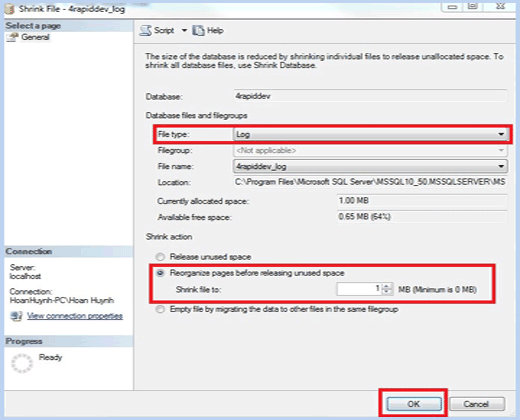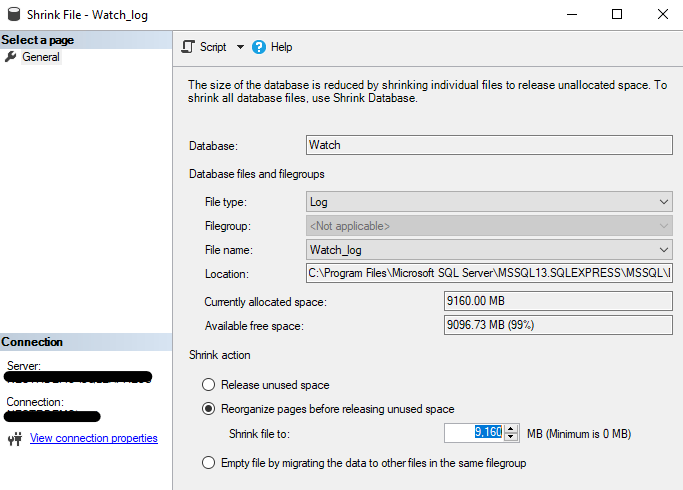
LDF files.You have to shrink & backup the log a several times to get the log file to reduce in size, this is because the the log file pages cannot be re-organized as data files pages can be, only truncated. Database to a simple recovery model and finally Ill shrink the log file.A very common problem that I see time and time again is the Log file growth of Microsoft SQL Server. Using T-SQL :- Dbcc Shrinkfile (LogLogicalName)The SQL Server log file for the ReportServer database was experiencing some. To Shrink the log file: Backup log DBName with NoLog Shrink the database by either: Using Enterprise manager :- Right click on the database, All tasks, Shrink database, Files, Select log file, OK. When the database is attached, a new transaction log file is created.
Database Displays the name of. Point to Tasks, point to Shrink, and then click Files. Expand Databases and then right-click the database that you want to shrink. The first parameter is.This problem can cause service outages when a hard disk is filled up completely by these massive LDF files.To shrink a data or log file In Object Explorer, connect to an instance of the SQL Server Database Engine and then expand that instance. WARNING : Detaching the db & deleting the log file How do I shrink the log files Youd use the following command to physically shrink the log file: DBCC SHRINKFILE (DataBaseNameLog, 0).
Sql 2016 Shrink Log File Full Recovery Mode
Solving the problemIdeally, you should start backing up the SQL Log files. Many people get confused and think they only have to backup the SQL Database file. In Full Recovery mode, the SQL Log files (.LDF files) must be backed up themselves, in addition to backing up the SQL Database. Table with Parquet, Orc, Avro - Hive SQL 1,265 Create, Drop, and Truncate Table - Hive SQL 2,915.The problem happens when a SQL Server Database is configured for Full Recovery mode (often the Default).

This method is the quickest, but you lose the ability to restore to a point in time from the last full backup, so perform this at your own risk. If your database is not in an AG or DM, then just switch the recovery model to simple, shrink the Log file using SQL Management Studio, then if needed, switch the recovery model back to full. Because your options are limited in this case.
Next, backup the Log file to free up space within the file (logically/virtually). Identify the culprit log files by running this query in SQL Management Studio:In my case, this showed two databases with log files > 65GB.2. =) If you have available disk space, you can always backup the SQL transaction log first before performing switching the recovery model from full to simple.Okay, so assuming you need to shrink a log file that is in an AG or DM, then the only method I have found that works is to perform the following (again, use at your own risk):1.
If your status is ‘2’ then you will need to proceed to step 4, otherwise if the Status is ‘0’ (Zero) then you can skip to step 5.4. Next, verify if the log file is in a state that will allow shrinking. Otherwise, if you are okay with an RPO of 24 hours (to your last full backup) then you can backup to a null device (great blog article here describing this method, please heed the disclaimers).Note: Technically you should be able to run this command against the primary replica or the secondary replica, and the log file will be truncated in both places according to this blog article.3.

Then add some cushion so that future physical log growth does not block transactions from occurring. Also, you may want to consider allowing the size of the log file to be 25% of the size of the physical database file (.MDF) because otherwise when log growth happens, the database operations will block all active transactions and that will cause latency within applications (imagine users complaining).You can determine how much of the log file is in use by running this query:SELECT name ,size/128.0 – CAST(FILEPROPERTY(name, ‘SpaceUsed’) AS int)/128.0 AS AvailableSpaceInMBSo to determine the size of the log file to shrink to, subtract the “AvailableSpaceInMB” from the physical database size reported by the command: DBCC SQLPERF(LOGSPACE).


 0 kommentar(er)
0 kommentar(er)
